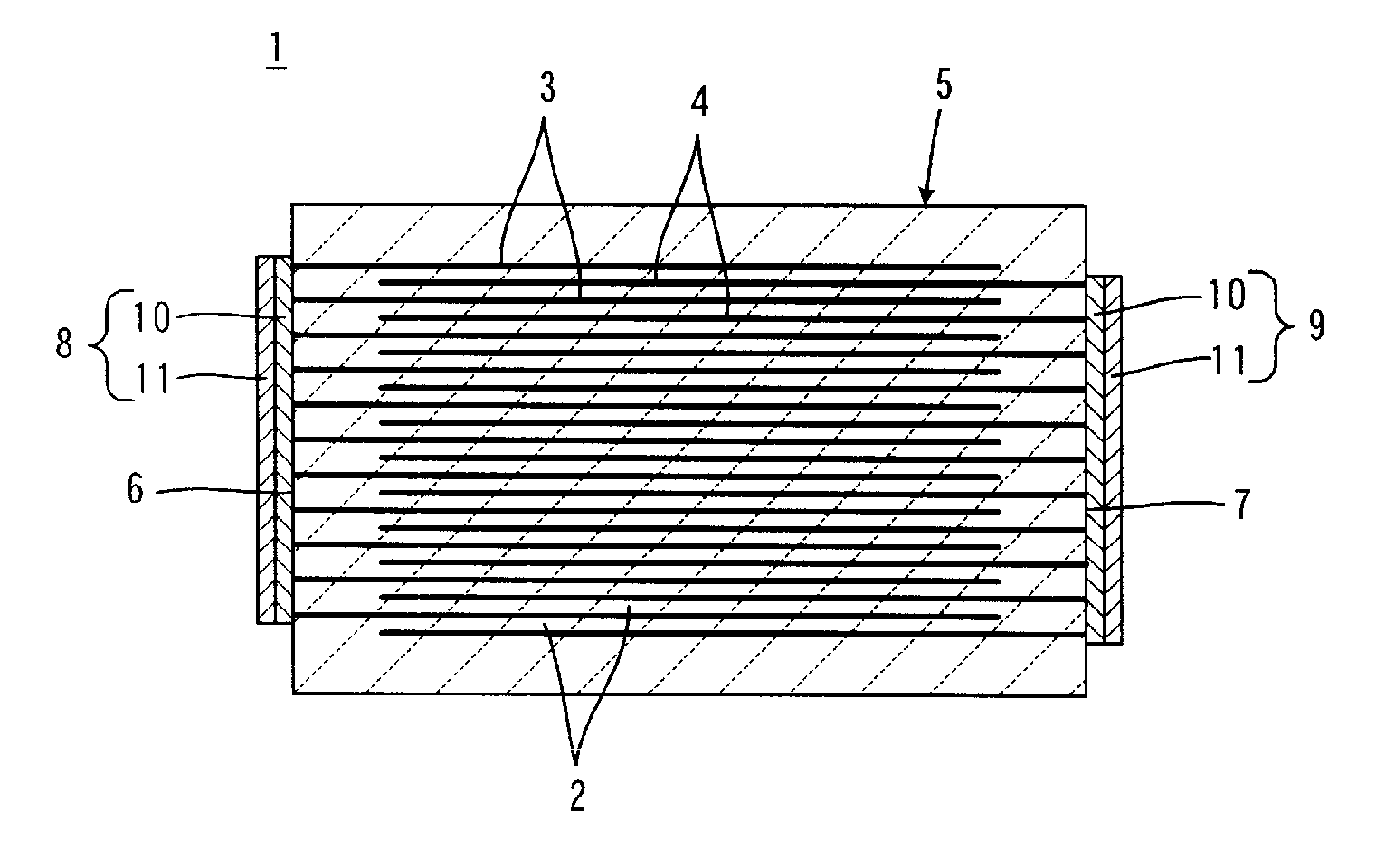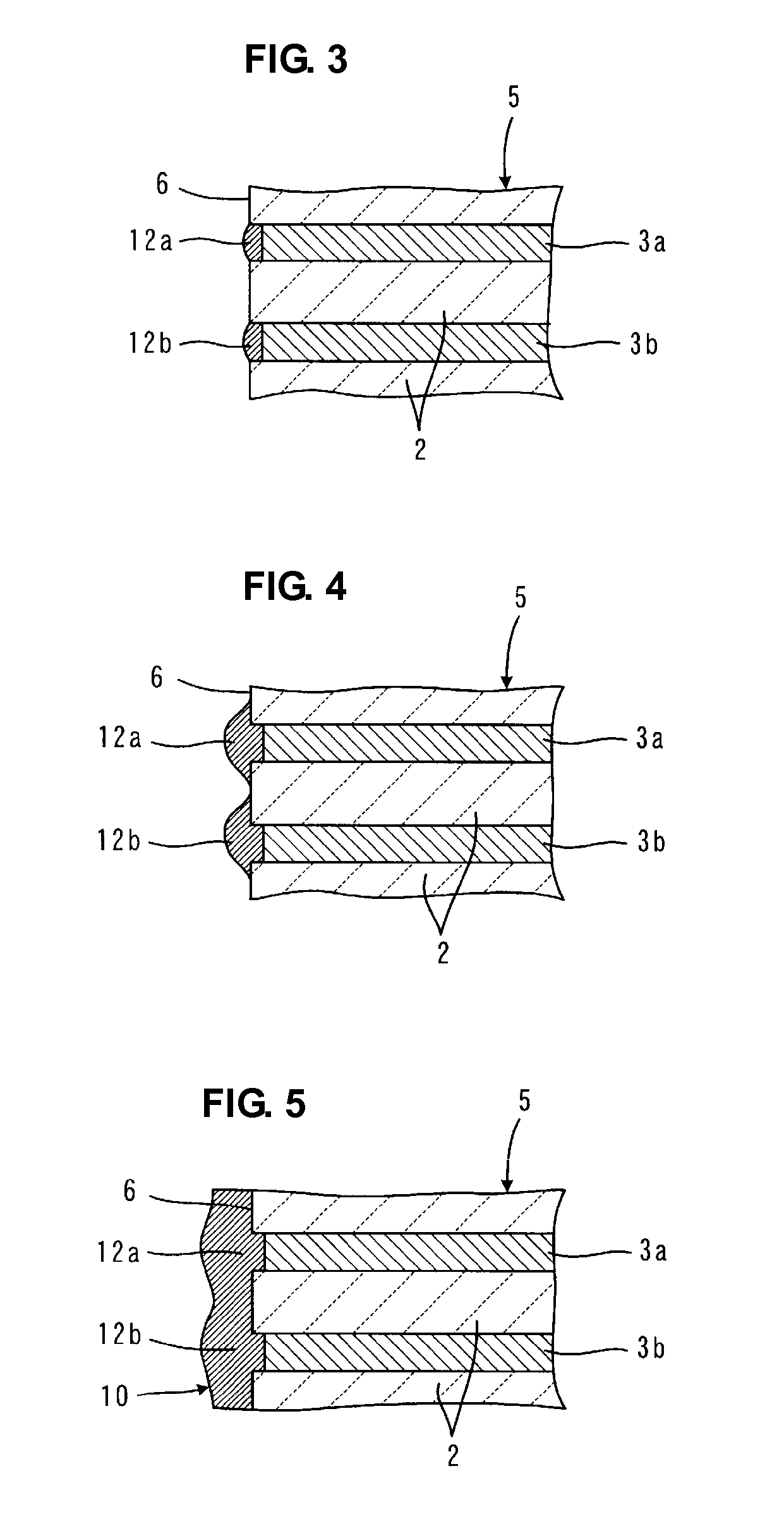Method of manufacturing multilayer electronic component
a technology of electronic components and manufacturing methods, applied in the direction of fixed capacitors, stacked capacitors, fixed capacitor details, etc., can solve the problems of reducing reliability, difficult step of applying conductive paste to specific portions, and low density and homogeneity of formed plating films, so as to improve the effective volume ratio
- Summary
- Abstract
- Description
- Claims
- Application Information
AI Technical Summary
Benefits of technology
Problems solved by technology
Method used
Image
Examples
experimental example 1
[0107]In Experimental Example 1, conductive media made of different materials were prepared for use in electroless plating. In a multilayer electronic component shown in FIG. 1, the influences of the materials used for the conductive media were examined when a first plating layer was formed, by electroless plating, directly on each of the end surfaces of a laminate in which internal electrodes were exposed.
[0108]In detail, a multilayer ceramic capacitor laminate having a length of about 1.6 mm, a width of about 0.8 mm, and a thickness of about 0.8 mm was prepared as a material to be plated, and the laminate included insulator layers composed of a barium titanate-based dielectric material and internal electrodes, the thickness and the main component of the internal electrodes being as shown in “Thickness of internal electrode” and “Main component of internal electrode” in Table 2. In the laminate, the thickness of the insulator layers, i.e., the distance “s” between the adjacent inte...
experimental example 2
[0116]In Experimental Example 2, the influence of the thickness of internal electrodes in a laminate on the quality of electroless plating was examined.
[0117]The same laminate as in Experimental Example 1 was used as a material to be plated except that the thickness and the main component of the internal electrodes were as shown in “Thickness of internal electrode” and “Main component of internal electrode” in Table 3.
[0118]Next, 5000 of the laminates and about 50 cc of each conductive medium having a diameter of about 0.2 mm were placed in a rotary barrel having a volume of about 300 cc, and an electroless Ni plating film having a thickness of about 8 μm was formed as a first plating layer on each of the end surfaces of each laminate, at which the internal electrodes were exposed, under the conditions A shown in Table 1 as shown in “Plating condition” in Table 3. In this case, the material of the conductive medium used was either Fe or Ni as shown in the column “Type of conductive ...
experimental example 3
[0125]In Experimental Example 3, the influence of barreling before electroless plating was examined, and first plating layers were formed by electroless plating using various metal ions or reducing agents.
[0126]The same laminate as in Experimental Example 1 was used as a material to be plated except that the thickness and the main component of the internal electrodes were as shown in “Thickness of internal electrode” and “Main component of internal electrode” in Table 4. Therefore, the withdrawn length “d” of the internal electrodes from each of the end surfaces of the laminate, in which the internal electrodes were exposed, was about 2.0 μm which was the same as in Experimental Example 1.
[0127]Next, as shown in Table 4, the laminate of each of Samples 22, 23, 24, 25, 26, 28, and 30 was barreled with an abrasive agent so that the maximum withdrawn length “d” of the internal electrodes from each of the end surfaces of the laminate, in which the internal electrodes were exposed, was a...
PUM
| Property | Measurement | Unit |
|---|---|---|
| diameter | aaaaa | aaaaa |
| length | aaaaa | aaaaa |
| length | aaaaa | aaaaa |
Abstract
Description
Claims
Application Information
 Login to View More
Login to View More - R&D
- Intellectual Property
- Life Sciences
- Materials
- Tech Scout
- Unparalleled Data Quality
- Higher Quality Content
- 60% Fewer Hallucinations
Browse by: Latest US Patents, China's latest patents, Technical Efficacy Thesaurus, Application Domain, Technology Topic, Popular Technical Reports.
© 2025 PatSnap. All rights reserved.Legal|Privacy policy|Modern Slavery Act Transparency Statement|Sitemap|About US| Contact US: help@patsnap.com



